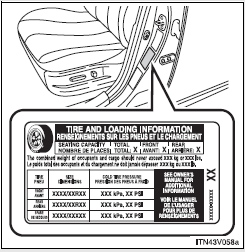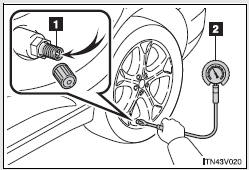Toyota Venza: Tire inflation pressure
- Tire inflation pressure
The recommended cold tire inflation pressure and tire size is displayed on the tire and loading information label.

- Inspection and adjustment procedure

1. Tire valve
2. Tire pressure gauge
 Remove the tire valve cap.
Remove the tire valve cap.
 Press the tip of the tire pressure
Press the tip of the tire pressure
gauge onto the tire valve.
 Read the pressure using the graduations
Read the pressure using the graduations
of the gauge.
 If the tire inflation pressure is
If the tire inflation pressure is
not within the recommended levels, adjust tire pressure.
If you add too much air, press the center of the valve to lower.
 After completing the tire inflation
After completing the tire inflation
pressure measurement and adjustment, apply soapy water to the valve and check for
leakage.
 Reinstall the tire valve cap.
Reinstall the tire valve cap.
- Tire inflation pressure check interval
You should check tire inflation pressure every 2 weeks, or at least once a month.
Do not forget to check the spare.
- Effects of incorrect tire inflation pressure
Driving with incorrect tire inflation pressure may result in the following:
• Reduced fuel efficiency
• Reduced driving comfort and tire life
• Reduced safety
• Damage to the drive train
If a tire needs frequent refilling, have it checked by your Toyota dealer.
- Instructions for checking tire inflation pressure
When checking tire inflation pressure, observe the following:
• Check only when the tires are cold.
If your vehicle has been parked for at least 3 hours or has not been driven for more than 1 mile or 1.5 km, you will get an accurate cold tire inflation pressure reading.
• Always use a tire pressure gauge.
The appearance of the tire can be misleading. In addition, tire inflation pressures that are even just a few pounds off can degrade ride and handling.
• Do not bleed or reduce tire inflation pressure after driving. It is normal for the tire inflation pressure to be higher after driving.
• Never exceed the vehicle capacity weight.
Passengers and luggage weight should be placed so that the vehicle is balanced.
CAUTION
- Proper inflation is critical to save tire performance
Keep your tires properly inflated. Otherwise, the following conditions may occur and result in an accident causing death or serious injury.
• Excessive wear
• Uneven wear
• Poor handling
• Possibility of blowouts resulting from overheated tires
• Poor sealing of the tire bead
• Wheel deformation and/or tire separation
• A greater possibility of tire damage from road hazards
NOTICE
- When inspecting and adjusting tire inflation pressure
Be sure to reinstall the tire valve caps.
Without the valve caps, dirt or moisture could get into the valve and cause air leakage, which could result in an accident. If the caps have been lost, replace them as soon as possible.
 Registering ID codes
Registering ID codes
The tire pressure warning valve and transmitter is equipped with a unique ID
code. When replacing a tire pressure warning valve and transmitter, it is necessary
to register the ID code of tire pre ...
 Wheels
Wheels
If a wheel is bent, cracked or heavily corroded, it should be replaced.
Otherwise, the tire may separate from the wheel or cause loss of handling control.
- Wheel selection
When replacing whe ...
Other materials about Toyota Venza:
Precaution
PRECAUTION
NOTICE:
When disconnecting the cable from the negative (-) battery terminal, initialize
the following systems after the cable is reconnected.
System Name
See Procedure
Back Door Closer System
...
Removal
REMOVAL
CAUTION / NOTICE / HINT
HINT:
The front side fix window assembly can be reused. When installing the
window, if any of the clips on the front side fix window assembly are broken,
butyl tape can be used to support the glass until the a ...
Installation
INSTALLATION
PROCEDURE
1. INSTALL SHIFT LEVER ASSEMBLY
NOTICE:
Check that the park/neutral position switch and the shift lever are in neutral.
(a) Slide the slider of the transmission control cable in the direction
indicated by the arrow an ...
0.1681
